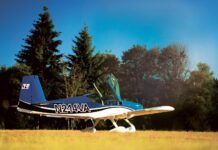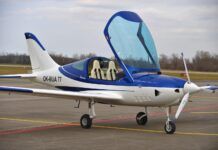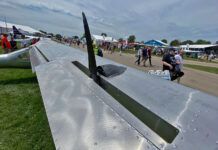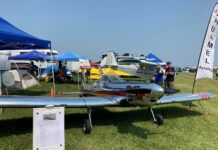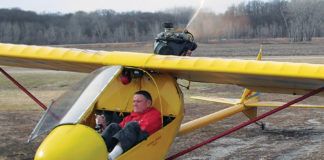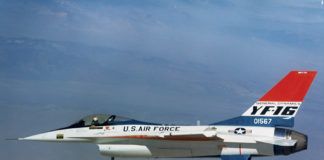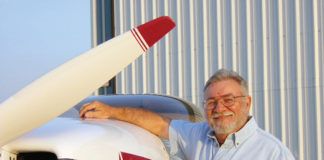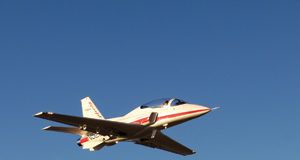From the name, you might guess that Gobosh Aviation-the company that imports a line of Light Sport Aircraft (LSAs)-is Asian or European. In fact, Gobosh is based in Moline, Illinois, and was founded by young American aviation businessmen. Tim Baldwin, president, and Dave Graham, vice president, head the company that imports low-wing LSAs, the all-metal Gobosh G700S and the composite G800XP. Gobosh, by the way, is a shortening of the entrepreneurial expression “go big or stay home.”
Baldwin and Graham have gone big in several ways. First, they are promoting their aircraft as the luxury end of the LSA spectrum. For example, even the least expensive Sport Edition G700S includes standard six-pack instrumentation, Garmin GPS and transponder, wheelpants and leather seats. Another example of starting with a splash is the recent addition of the composite G800XP two-seater to the line.
Mods for America
The G700S line is made in Poland by Aero, a successful company founded in 1994 and producer of several type-certified light airplanes for the European market. The 700 is an Americanized version of Aero designer Tomasz Antoniewskis certified AT-3.
To qualify as an LSA and therefore become eligible for Sport Pilots to fly, the wingspan was increased (no doubt to meet the 45-knot maximum clean stall requirement). Other changes for the U.S. market were the addition of winglets, American avionics and a substantially different panel layout including the standard six-flight-instrument cluster.
Some G700 Details
The G700 features include a 41-inch-wide cabin, wonderful cockpit visibility, dual controls, mechanically operated split flaps, a stabilator for pitch control and 18.5-gallon fuel capacity. With full fuel, the remaining payload before you hit the 1320-pound LSA maximum is 390 pounds. That results from an empty weight of 820 pounds, which is more than many other SLSAs. But Gobosh notes that empty weight includes its standard full bag of instruments and avionics. There are separate gauges for airspeed, altimeter, attitude, turn and bank, VSI and heading plus a com transceiver, GPS, transponder and engine instruments.
The Sport Edition is intended for day VFR flight only. The next-level Elite Edition adds a PS Engineering PM3000 stereo intercom, two-tone paint (white plus red or blue) and matching two-tone leather seats. (The basic Sport Edition comes in white with a choice of vinyl stripes plus gray leather.) The top Elite Plus Edition includes a nav/com with CDI and upgrades to a Garmin 396 with XM Weather radio.
The airframe warranty is two years or 400 hours. Insurance and financing are available through Gobosh. Prices as this is written are $109,900, $123,700 and $129,990, respectively, including shipment to the U.S., assembly and FAA registration.
Let’s Fly It
Following a walk-around, Gobosh demo pilot Tony Settember and I climbed aboard. This G700 Elite Edition had flown a few hours earlier, so we skipped the famous Rotax burping-the-engine-oil check. A castering nosewheel and differential toe brakes, as found on many other LSAs, allow short-radius ground handling. Turning and braking require only a gentle touch with the toes.
The weather at Sebring, Florida, was clear and windy with gusts down the runway to more than 20 knots. Therefore, we were in no hurry for liftoff during the takeoff run, and Settember advised climbing at 65 knots for more solid control instead of the best-climb 58 knots. The climb rate was close to 750 fpm with the two of us and 14 gallons of fuel-about 100 pounds under maximum gross weight (1320 pounds).
Outside the traffic pattern, I got the feel of the 700S with a few clearing turns, and we spent considerable time checking stall behavior.
First I tried a partial-power (5000 rpm) departure stall. The electrical stall warning came on at 40 knots with 3 to 5 pounds of right rudder pressure approaching the stall and 2 to 3 pounds of back stick. The stall itself was docile and without a wing drop.
An approach stall was sampled with idle power and 15 of flaps. Trimmed for a 50-knot, half-flap approach, slowing toward stall speed required lots of back pressure and yielded obvious buffeting. Again the warning sounded at 40 knots, and the stall break occurred at 38 indicated. Easing back pressure broke the stall, and altitude loss was minimal even without adding full power. Wide-awake pilots should easily recognize an approaching stall in this airplane, at least if they are keeping the slip/skid ball near the center.
Settember demonstrated on-the-edge slow flight at 3800 rpm, noting that at 40 knots, banks up to 25 are easily controlled. He yanked and pulled for an accelerated departure stall at 60 of bank, raising the stall speed 41%. Still, nothing alarming occurred, but I recommend trying this first with a Gobosh checkout instructor and at a reasonable altitude. Slow flight was predictably comfortable, with or without trimming for it. The mechanical trim wheel is in the console between the seats.
At maximum continuous power-5500 rpm on the Rotax tach-we indicated 115 knots at 5700 feet with outside air temp at 60 F. That works out to 120 knots true airspeed. At this speed and power setting, I removed my headset and found the cockpit to be relatively quiet. Flying with headsets is of course the way to go, but you could carry on a conversation without them.
I tried the stick-free pitch stability check. Two phugoid cycles after pitching up or down got us back to trimmed attitude and airspeed, and the damping was quick.
Heading back into the special 400-foot AGL pattern used for LSAs, we used a 65-knot approach because of the wind and gustiness. Turning final for the runway (usually a taxiway), we slowed to 45 knots on short final with full flaps (40). Touchdown was soft. The Gobosh G700S handles exceptionally well, even in less than ideal conditions.
A lasting impression is that the G700 has considerably heavier controls than many LSAs and therefore feels more like flying a GA airplane, which may help some pilots feel comfortable. But wing loading is less, so the experienced pilot needs to pay more than the usual attention to wind and get more than a cursory checkout in ideal conditions.
Other Considerations
LSA dealers and aviation insurance companies have noted a disturbing trend: High-time general aviation pilots without experience in low-wing-loading airplanes such as LSAs have high accident rates early in their LSA flying experience. That fact combined with lack of parts for repairs of some LSAs-particularly the imported ones-has resulted in high insurance costs. As noted recently in this column, Avemco has mandated a minimum of 5 hours of transition training for every LSA buyer regardless of previous experience.
Like some other importers, Gobosh has attacked the problem from two directions. First, the price of its aircraft includes transition training. Second, the company stocks parts so that repairs and maintenance can be completed in a reasonable time.
At some point, we expect to sample Goboshs composite G800XP, which Settember says flies quite differently. I look forward to that.
For more information on both aircraft, visit http://www.gobosh.aero/. You can find a direct link at http://www.kitplanes.com/.




